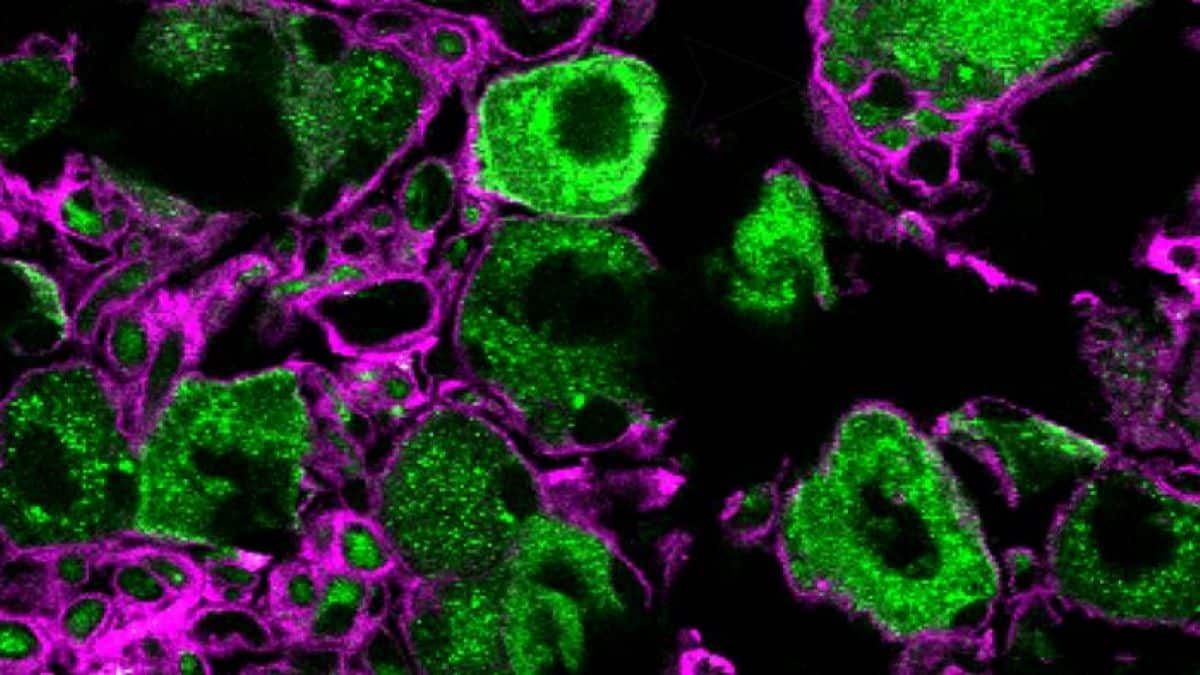Summary: Researchers identified a new receptor, neuropilin-1 (NRP1), which collaborates with a known receptor to regulate pain signaling from nerve growth factor. Unlike traditional signaling receptors, NRP1 acts as a co-receptor to enhance pain signals without directly transmitting them.
The study showed how blocking NRP1 or disrupting its interaction with nerve growth factor could offer novel approaches to pain treatment. Using molecular modeling, the researchers uncovered a complex involving nerve growth factor, NRP1, and other proteins that amplifies pain signals.
The findings pave the way for developing peptide-based and targeted therapies to address chronic and inflammatory pain. This research marks a significant step toward safer, non-opioid pain management solutions.
Key Facts:
- New Pain Target: Neuropilin-1 (NRP1) is a co-receptor required for nerve growth factor to signal pain effectively.
- Therapeutic Potential: Blocking NRP1 with monoclonal antibodies or disrupting its complex with nerve growth factor shows promise for safer pain relief.
- Chronic Pain Link: The interaction of NRP1, nerve growth factor, and TrkA may sustain chronic pain through intracellular signaling mechanisms.
Source: NYU
Researchers at the NYU Pain Research Center have found a new receptor for nerve growth factor that plays an important role in pain signaling, even though it does not signal on its own, according to a study published in the Journal of Clinical Investigation.
The findings hold promise for finding new treatments for arthritis and other forms of inflammatory and cancer pain, without the side effects that led recent therapies to fail in clinical trials.

“Nerve growth factor is unusual because it’s one of the few patient-validated targets for pain,” said Nigel Bunnett, professor and chair of the Department of Molecular Pathobiology at NYU College of Dentistry and the study’s senior author.
“We wanted to think of a way of circumventing side effects in an effort to find safer, non-opioid therapies for arthritis and other forms of chronic pain.”
Nerve growth factor is a protein that stimulates the development of neurons. It is also a powerful driver of pain in animals and humans, and is released by cells from injured or diseased tissue. To transmit pain signals, nerve growth factor binds to a receptor called tropomyosin receptor kinase A, or TrkA.
Monoclonal antibodies—lab-made proteins that mimic our natural antibodies and bind to specific proteins to treat diseases—have emerged as a promising treatment for chronic pain by targeting nerve growth factor and sequestering it.
In large clinical trials, monoclonal antibodies relieved osteoarthritis pain better than placebo or other drugs, but because some patients experienced worsening joint damage, the treatments were not approved.
How a non-signaling receptor regulates pain signals
In a series of studies using mouse and human neurons, the researchers discovered a new receptor for nerve growth factor: neuropilin-1 (NRP1), a protein expressed in neurons and other cell types.
To determine this, they observed that nerve growth factor has a stretch of amino acids that is known to allow other proteins to bind to NPR1. NRP1 was also expressed in the same cells at the nerve growth factor receptor TrkA.
Examining pain-sensing neurons, the researchers found that NRP1 could bind to nerve growth factor with high affinity, and when NRP1 was blocked in neurons from both mice and humans, it inhibited nerve growth factor from signaling pain.
The researchers concluded that NRP1 is a co-receptor for nerve growth factor, as—unlike TrkA—NRP1 is not known to signal on its own.
“Our findings suggest that neuropilin-1 is required for nerve growth factor to signal pain, even if it is indirectly regulating it,” said Bunnett.
In further cellular studies, the researchers discovered two mechanisms that explain the NRP1’s role in pain. First, when binding to nerve growth factor, NRP1 increases the local concentration of nerve growth factor that is presented to TrkA, the signaling receptor. In addition, NRP1 was found to be a molecular chaperone, or a protein that aids in the trafficking of other proteins in the cell—in this case, TrkA.
NRP1 interacts with TrkA and brings it from the interior of the cell to the plasma membrane on the surface. This increases the amount of TrkA on the cell’s surface to recognize nerve growth factor and signal pain.
The researchers then used molecular modeling to better understand the interactions between nerve growth factor, TrkA, and NRP1 at the surface of cells. Their modeling suggests that two molecules of nerve growth factor, two molecules of TrkA, and two molecules of NRP1 together form a pain signaling complex.
Finally, the researchers identified a protein, G Alpha Interacting Protein C-terminus 1 (GIPC1), that appears to play a critical role in connecting TrkA and NRP1 and signaling pain. GIPC1 links TrkA and NRP1 to a specific molecule that transports the pain signaling complex into the cell’s interior, which may lead to sustained or chronic pain.
A “springboard” for pain treatments
Given the newfound role of NRP1 in nerve growth factor pain signaling, the researchers envision several ways that this knowledge can be used to redeploy existing therapies to treat pain and create new ones.
Blocking NRP1 with established compounds is one option, as NRP1 inhibitors—including monoclonal antibodies—have already been developed to treat cancer.
“We could test these monoclonal antibodies that target NRP1 in models of pain,” said Bunnett.
“Because these treatments would target receptors at the surface of pain-sensing neurons, this specificity might avoid the side effects seen with other monoclonal antibodies that sequester all nerve growth factor in the body.”
The researchers are also harnessing their new understanding of the pain signaling complex, determining the sites at which nerve growth factor, TrkA, and NRP1 interact, and generating peptides that disrupt them.
In the Journal of Clinical Investigation study, the researchers created one such peptide that blocked the ability of nerve growth factor to interact with NRP1, which stopped pain in cellular studies.
“We can use this information as a springboard to develop new peptide-based analgesics that prevent this signaling complex from forming,” said Bunnett.
Additional study authors include Chloe Peach (now at the University of Nottingham), Raquel Tonello, Elisa Damo, Renato Bruni, Harsh Bansia, Ana-Maria Manu, Hyunggu Hahn, Alex Thomsen, Brian Schmidt, Steve Davidson, and Amedee des Georges of the NYU Pain Research Center at NYU College of Dentistry; Kimberly Gomez, Aida Calderon-Rivera, and Rajesh Khanna of the University of Florida College of Medicine; and Laura Maile of the University of Cincinnati.
Funding: The research was supported in part by the National Institutes of Health (NS102722, DK118971, DE026806, DE029951, RM1DE033491, GM147088, GM133598, NS098772, NS120663, DA042852, NS134965) and the Department of Defense (W81XWH1810431, W81XWH2210239). Bunnett is a founding scientist of Endosome Therapeutics Inc. Research in Bunnett’s laboratory is funded, in part, by Takeda.
About this pain research news
Author: Rachel Harrison
Source: NYU
Contact: Rachel Harrison – NYU
Image: The image is credited to Bunnett Lab
Original Research: Open access.
“NEUROPILIN-1 INHIBITION SUPPRESSES NERVE-GROWTH FACTOR SIGNALING AND NOCICEPTION IN PAIN MODELS” by Nigel Bunnett et al. Journal of Clinical Investigation
Abstract
NEUROPILIN-1 INHIBITION SUPPRESSES NERVE-GROWTH FACTOR SIGNALING AND NOCICEPTION IN PAIN MODELS
Nerve growth factor (NGF) monoclonal antibodies inhibit chronic pain yet failed to gain approval due to worsened joint damage in osteoarthritis patients.
We report that neuropilin-1 (NRP1) is a co-receptor for NGF and tropomyosin-related kinase A (TrkA) pain signaling. NRP1 was coexpressed with TrkA in human and mouse nociceptors. NRP1 inhibitors suppressed NGF-stimulated excitation of human and mouse nociceptors and NGF-evoked nociception in mice.
NRP1 knockdown inhibited NGF/TrkA signaling, whereas NRP1 overexpression enhanced signaling. NGF bound NRP1 with high affinity and interacted with and chaperoned TrkA from the biosynthetic pathway to the plasma membrane and endosomes, enhancing TrkA signaling.
Molecular modeling suggested that C-terminal R/KXXR/K NGF motif interacts with extracellular “b” NRP1 domain within a plasma membrane NGF/TrkA/NRP1 of 2:2:2 stoichiometry. G Alpha Interacting Protein C-terminus 1 (GIPC1), which scaffolds NRP1 and TrkA to myosin VI, colocalized in nociceptors with NRP1/TrkA. GIPC1 knockdown abrogated NGF-evoked excitation of nociceptors and pain-like behavior.
Thus, NRP1 is a nociceptor-enriched co-receptor that facilitates NGF/TrkA pain signaling. NRP binds NGF and chaperones TrkA to the plasma membrane and signaling endosomes via GIPC1 adaptor.
NRP1 and GIPC1 antagonism in nociceptors offers a long-awaited non-opioid alternative to systemic antibody NGF sequestration for the treatment of chronic pain.






